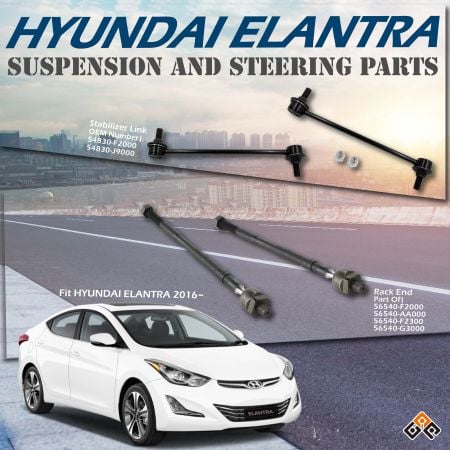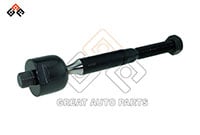How to Tell if Tie Rod is Bad?
What Makes a Tie Rod So Important
The tie rod is a key player in your car’s steering system. It connects the steering rack to the wheels, ensuring they move in unison with your steering wheel. If it goes bad, your steering becomes unpredictable, and your car’s alignment can spiral out of control. Knowing how to tell if a tie rod is bad helps you catch issues early before they escalate into major safety hazards.
Key Signs Your Tie Rod Is Bad
Recognizing the symptoms of a bad tie rod can save you from costly repairs or worse, unsafe driving conditions:
| Symptom | What It Means |
| Loose Steering Wheel | Unresponsive or sloppy steering, indicating wear in the tie rod. |
| Unusual Noises | Clicking, clunking, or knocking sounds, especially when turning or hitting bumps. |
| Vibrations | Shaking steering wheel, particularly noticeable at higher speeds. |
| Uneven Tire Wear | One-sided tire damage due to misalignment caused by a bad tie rod. |
| Pulling to One Side | The vehicle drifts to one side, even on a straight road. |
Each of these symptoms is a clue in learning how to tell if a tie rod is bad—and why acting quickly is so important.
How to Test for a Bad Tie Rod
Think your tie rod might be the issue? A quick test can help confirm it:
| Test Step | What to Do |
| Raise the Car Safely | Use a jack to lift the front wheels and secure with jack stands. |
| Inspect the Tie Rods | Look for visible signs of wear, such as cracks, rust, or rubber boot damage. |
| Perform the Wiggle Test | Grab the tire and move it side-to-side; excessive play or clicking suggests tie rod wear. |
| Check Wheel Alignment | Misaligned wheels are a common sign of tie rod problems. |
While these tests can help you identify problems, a mechanic can provide a professional diagnosis and check for other potential issues.
Why You Shouldn’t Ignore a Bad Tie Rod
Ignoring a failing tie rod can lead to severe consequences:
| Consequence | Impact |
| Loss of Steering Control | A completely worn-out tie rod can snap, leaving you unable to steer. |
| Accelerated Tire Damage | Misalignment causes uneven tire wear, shortening tire lifespan. |
| Additional Suspension Damage | Extra stress on ball joints and control arms leads to costly repairs. |
| Safety Risks | Compromised steering control makes it harder to avoid obstacles or navigate at high speeds. |
Knowing how to tell if a tie rod is bad—and acting on it—helps you avoid these dangers and costly repairs.
What Causes Tie Rods to Fail
Tie rods are tough, but they’re not invincible. Here’s what can wear them down:
| Cause | Impact on Tie Rods |
| Rough Roads | Potholes, gravel, and uneven surfaces wear out tie rods over time. |
| Corrosion | Salt from winter roads accelerates rust, weakening the tie rod material. |
| Lack of Lubrication | Dry joints increase friction, leading to faster wear and tear. |
| Heavy Loads/Aggressive Driving | Overloading or sharp turns place unnecessary stress on tie rods. |
Understanding these causes can help you avoid unnecessary wear and tear and extend the life of your tie rods.
When Should You Replace a Bad Tie Rod
If you spot the warning signs, don’t delay. Here’s when replacement is necessary:
- Visible Damage:
Cracked or rusted tie rod ends indicate they’re past their prime. - Failed Tests:
If your tie rod fails the wiggle test or shows signs of misalignment, replacement is likely needed. - Routine Maintenance:
Many tie rods last 50,000 to 70,000 miles, but extreme conditions may shorten their lifespan.
Replacing a bad tie rod not only restores your car’s steering but also prevents further damage to other components.
How to Prevent Tie Rod Problems
While tie rod wear is inevitable, you can take steps to slow it down:
| Tip | Why It Helps |
| Regular Inspections | Catch issues early during routine maintenance. |
| Avoid Rough Driving | Protects tie rods from excessive wear caused by potholes or rough terrain. |
| Protect Against Corrosion | Washing away road salt reduces rust buildup. |
| Invest in Quality Parts | Durable tie rods perform better and last longer under stress. |
Learning how to tell if a tie rod is bad is only part of the equation. Preventive care ensures your tie rods last as long as possible.
Why Choose Great Auto Parts for Tie Rod Replacements
When it’s time to replace your tie rod, quality matters. Here’s why Great Auto Parts is the best choice:
| Feature | Benefit |
| Built to Last | Made with durable materials to withstand tough conditions. |
| Low Minimum Order Quantities | Perfect for B2B customers, with orders starting as low as 30 pieces. |
| Custom Solutions | Tailored sizes and designs for specific needs. |
| Fast, Reliable Shipping | Minimizes downtime with quick delivery. |
| Trusted by Professionals | Known for reliable, long-lasting performance. |
When you need replacements, knowing how to tell if a tie rod is bad is step one. Choosing Great Auto Parts is step two.
Tie rods may seem like small components, but they have a big impact on your car’s safety and performance. Understanding how to tell if a tie rod is bad, addressing the symptoms early, and replacing it with high-quality parts ensures your vehicle stays safe and road-ready. Trust Great Auto Parts




